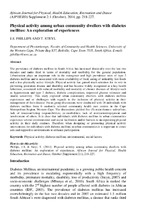| dc.contributor.author | Phillips, Julie | |
| dc.contributor.author | Steyl, Tania | |
| dc.date.accessioned | 2017-05-05T08:03:01Z | |
| dc.date.available | 2017-05-05T08:03:01Z | |
| dc.date.issued | 2014 | |
| dc.identifier.citation | Phillips, J. & Steyl, T. (2014). Physical activity among urban community dwelling individuals with diabetes mellitus: an exploration of experiences. African Journal of Physical Education, Health, Recreation & Dance, Supplement 2(1): 218-227. | en_US |
| dc.identifier.issn | 1117-4315 | |
| dc.identifier.uri | http://hdl.handle.net/10566/2799 | |
| dc.identifier.uri | http://hdl.handle.net/10520/EJC19537 | |
| dc.description.abstract | The prevalence of diabetes mellitus in South Africa has increased drastically over the last two decades and ranks third in terms of mortality and morbidity for the general population. Urbanisation plays an important role in the emergence and high prevalence rates of type 2 diabetes mellitus and is associated with more availability of food, eating of unhealthy fast foods and a less physically active lifestyle. Physical activity has gained much attention for its role in preventing premature disease and disability and has become widely recognised as a key health behaviour, associated with reduced morbidity and mortality of chronic diseases of lifestyle such as hypertension and type 2 diabetes, diabetic complications, improved glucose tolerance and insulin sensitivity. This study explored urban community dwellers with diabetes mellitus experiences and or challenges with regards to the inclusion of physical activity in their management of their disease. Focus group discussions were conducted with 26 individuals with diabetes mellitus from 6 randomly selected community health care centres in the Cape Metropolitan Region, Western Cape. The discussions yielded five (5) main themes: safety/fear; lack of time/conflicting responsibilities; co-morbidities; lack of motivation/enjoyment and involvement of others. It is clear that individuals with diabetes mellitus in urban communities experience several environmental and social facilitators and/or barriers to incorporating physical activity in their daily routines. Therefore when designing or promoting physical activity interventions for individuals with diabetes mellitus in urban communities it is important to create safe and supportive environments to enhance participation. | en_US |
| dc.language.iso | en | en_US |
| dc.publisher | AFAHPER-SD | en_US |
| dc.rights | Publisher retains copyright. Authors may archive the published version in their institutional repository. | |
| dc.subject | Diabetes mellitus | en_US |
| dc.subject | Environment | en_US |
| dc.subject | Social factors | en_US |
| dc.title | Physical activity among urban community dwelling individuals with diabetes mellitus: an exploration of experiences | en_US |
| dc.type | Article | en_US |
| dc.privacy.showsubmitter | FALSE | |
| dc.status.ispeerreviewed | TRUE | |
| dc.description.accreditation | DHET | |

